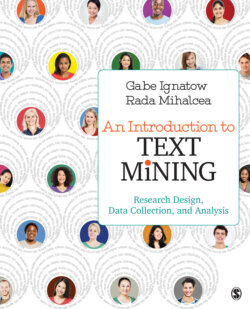Читать книгу An Introduction to Text Mining - Gabe Ignatow - Страница 25
На сайте Литреса книга снята с продажи.
Historical Research Methods
ОглавлениеArchival research methods are among the oldest methods in the social sciences. The founding fathers of sociology—Marx, Weber, and Durkheim—all did historical scholarship based on archival research, and today, archival research methods are widely used by historians, political scientists, and sociologists.
Historical researchers have adapted digital technology to archival research in two waves. The first occurred in the 1950s and 1960s when, in the early years of accessible computers, historians taught themselves statistical methods and programming languages. Adopting quantitative methods developed in sociology and political science, during this period historians made lasting contributions in the areas of “social mobility, political identification, family formation, patterns of crime, economic growth, and the consequences of ethnic identity” (Ayers, 1999). Unfortunately, however, that quantitative social science history collapsed suddenly, the victim of its own inflated claims, limited method and machinery, and changing academic fashion. By the mid-80s, history, along with many of the humanities and social sciences, had taken the linguistic turn. Rather than SPSS guides and codebooks, innovative historians carried books of French philosophy and German literary interpretation. The social science of choice shifted from sociology to anthropology; texts replaced tables. A new generation defined itself in opposition to social scientific methods just as energetically as an earlier generation had seen in those methods the best means of writing a truly democratic history. The first computer revolution largely failed (Ayers, 1999).
Beginning in the 1980s, historians and historically minded social scientists began to reengage with digital technologies. While today historical researchers use digital technologies at every stage of the research process, from professional communication to multimedia presentations, digital archives have had perhaps the most profound influence on the practice of historical research. Universities, research institutes, and private companies have digitized and created accessible archives of massive volumes of historical documents. Historians recognize that these archives offer tremendous advantages in terms of the capacity, flexibility, accessibility, flexibility, diversity, manipulability, and interactivity of research (Cohen & Rosenzweig, 2005). However, digital research archives also pose dangers in terms of the quality, durability, and readability of stored data. There is also a potential for inaccessibility and monopoly and also for digital archives to encourage researcher passivity (Cohen & Rosenzweig, 2005).
There are lessons to be learned from digital history for text mining and text analysis, particularly from the sudden collapse of the digital history movement of the 1950s and 1960s. In light of the failure of that movement, it is imperative that social scientists working with text mining tools recognize the limitations of their chosen methods and not make imperious or inflated claims about these tools’ revolutionary potential. Like all social science methods, text mining methods have benefits and drawbacks that must be recognized from the start and given consideration in every phase of the research process. And text mining researchers should be aware of historians’ concerns about the quality of data stored in digital archives and the possibility for digital archives to encourage researcher passivity in the data gathering phase of research.
Conclusion
This chapter has introduced text mining and text analysis methodologies, provided an overview of the major approaches to text analysis, and discussed some of the risks associated with analyzing data from online sources. Despite these risks, social and computer scientists are developing new text mining and text analysis tools to address a broad spectrum of applied and theoretical research questions, in academia as well as in the private and public sectors.
In the chapters that follow, you will learn how to find data online (Chapters 2 and 6), and you will learn about some of the ethical (Chapter 3) and philosophical and logical (Chapter 4) dimensions of text mining research. In Chapter 5, you will learn how to design your own social science research project. Parts II, IV, and V review specific text mining techniques for collecting and analyzing data, and Chapter 17 in Part VI provides guidance for writing and reporting your own research.
